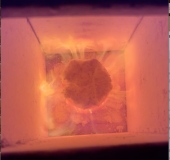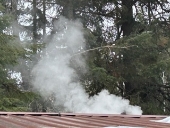Two more tests and I managed to solve the smoke on refuelling, but at the expense of a slower start. Not that slow though, so think I'm getting closer to a better balance.
Test 1
Port 1 (firebox to secondary chamber) at 40% CSA and Port 2 (the horseshoe between secondary chamber and riser) the same. It took around 15 minutes or so for the smoke to disappear completely, but it burned very clean after this, with no smoke at all on refuel.
Had a peak down the riser - flames were just periodically licking the bottom of the riser, suggesting gas had ample time and space to combust. Looking in the firebox, it was much slower than previous attempts with bigger ports, flames gently licking the ceiling and not rushing at speed towards the back, suggesting more combustion is allowed to happen in here.
Test 2
Port 1: 40%, Port 2 100%. I just wanted to see what would happen here and how these two ports interacted. Things got off to a quicker start, but it was already quite warm from the previous burn.Secondary combustion started after around 8 minutes, then burned clean and again no smoke on refuel. Things looked a little faster inside the firebox, but perhaps also a little uneven. I didn't hear any traction engines, but something faintly resembling them. My guess is that increasing the second port has increased the draft a little but also potentially put it a bit out of balance, so I'll keep these the same size for now going forwards.
As with the previous burn, I had a look down the riser and flames were only really just licking the bottom, ample time and space to burn off all the gasses. I'd hazard a guess that a shorter or thinner riser could probably work with this smaller port.
I'm seeing how critical the port size is to everything else. Things get going much more quickly with a bigger port, but too big and it can overfuel if it doesn't have enough time/space in secondary combustion. Smaller port means slower to get going, but also potentially enables a smaller secondary combustion zone and can handle refuels without a hitch.
I wonder if anyone has implemented a damper on the port itself, rather than the air, in order to facilitate a rapid start, but slow things down once going?
I'm planning to gradually increase both port sizes from 40%, until I see smoke on refuel, so I get an idea of where the limit is for this particular size/shape secondary combustion zone. The first test with Shorty style riser smoked on refuel and had a 66% port, so in theory it should be somewhere between these.
Following this, I might try something different for the secondary combustion zone, then attempt to gauge the size of the port required for this, kind of the opposite way I'm doing things at the moment. I wondered if I could get away with a much smaller path to the riser, which would free up more space in the bell for heat extraction.


Essentially, I'd build a little vortex box on top of the main fire chamber, so gasses exit out the rear port, then get funnelled towards the central riser. James, if you're reading this far, I think this is similar to your vortex J tube, but you have your riser behind your main fire chamber and here its on top.

 2
2




 2
2







 2
2




 2
2






 3
3




 3
3








 4
4

















